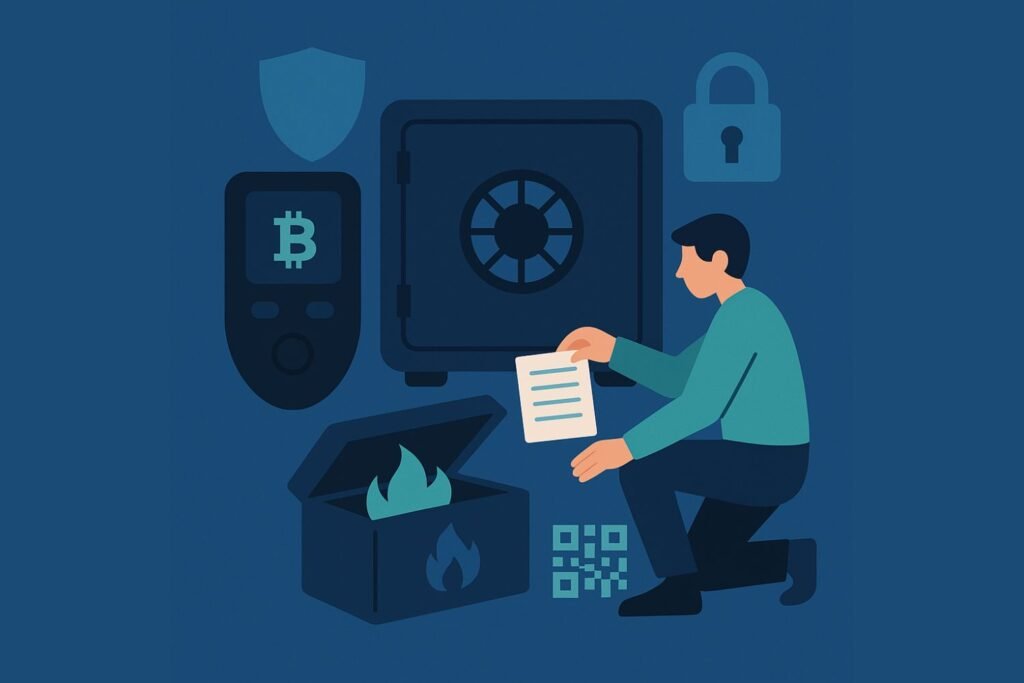⚠︎ Disclaimer: Cryptocurrency is a high-risk asset class. This content is for informational purposes only and does not constitute financial or investment advice. You may lose all of your capital. KoinGuide may earn a commission if you visit or sign up with a recommended provider via our affiliate links—at no additional cost to you. All recommendations are based on our independent reviews and evaluation process.
Best Practices for Crypto Storage

Cryptocurrency has become a powerful force in the world of finance. Millions of people around the globe buy, sell, and hold digital assets like Bitcoin, Ethereum, meme coins and many others. However, unlike traditional money stored in banks, cryptocurrencies require you to be your own bank. This means you are fully responsible for keeping your crypto safe.(sound like the bank onwer) If you lose your private keys or get hacked, there is often no way to recover your funds.
Because of this, knowing the best ways to store your crypto securely is essential. In this article, we will explain the best practices for crypto storage in 2025, helping you protect your investments from theft, loss, and mistakes.
Comparision of Hot Wallets vs. Cold Wallets, which best for
The first step to safe crypto storage is understanding the two main types of wallets:
-
Hot Wallets: These wallets are connected to the internet. Examples include mobile apps like ” trust wallets, exdous, metamask”, desktop wallets, and wallets provided by exchanges. Hot wallets are convenient for quick access and regular trading. However, because they are online, they are more vulnerable to hacking, malware, and phishing attacks.
-
Cold Wallets: Cold wallets keep your private keys offline. This includes hardware wallets (physical devices eg ledger wallets, trezor model t ), paper wallets (your keys printed on paper), and air-gapped computers (devices never connected to the internet). Cold wallets are much safer for storing large amounts of crypto or holding coins long term because hackers cannot reach them remotely/offline
Best Practical: You can use hot wallets only for small amounts you plan to use soon. Store the majority of your funds in cold wallets for maximum security.
Hardware Wallets: The Gold Standard of Crypto Security
Hardware wallets, such as Ledger Nano X or Trezor Model T, are widely regarded as the safest way to store cryptocurrencies. These small devices store your private keys offline and sign transactions without exposing your keys to the internet.
Why use hardware wallets?
-
They protect your keys from viruses and malware on your computer.
-
Even if your computer is compromised, your crypto remains secure.
-
They often include PIN protection and passphrase options for extra layers of security.
Tips for hardware wallet use:
-
Buy hardware wallets only from official manufacturers or trusted resellers to avoid tampered devices.
-
Set a strong PIN and use any additional security features available.
-
Keep your hardware wallet firmware updated to protect against new vulnerabilities.
The Importance of Your Recovery Phrase
When you create a wallet, you receive a recovery phrase (also called a seed phrase). This is a list of 12, 18, or 24 words that can restore your wallet if you lose access to your device.
How to protect your recovery phrase:
-
Write it down on paper clearly and legibly.
-
Store the paper in a secure, private location such as a fireproof safe or a bank safety deposit box.
-
Make multiple copies and keep them in different secure locations to avoid loss from fire, theft, or damage.
-
Never store your recovery phrase digitally (on your phone, computer, cloud storage, or email) because hackers can steal it.
-
Do not share your recovery phrase with anyone. No legitimate service or support team will ever ask for it.
Strong Passwords and Two-Factor Authentication (2FA)
Passwords are your first line of defense for online accounts and wallets.
-
Create long, unique passwords using a mix of letters, numbers, and symbols.
-
Avoid using the same password across multiple sites.
-
Use a trusted password manager to generate and store your passwords securely.
Two-factor authentication (2FA) adds an extra step when logging in, usually requiring a code from your phone or an authentication app.
-
Always enable 2FA on your exchange accounts and wallets.
-
Avoid SMS-based 2FA if possible, as text messages can be intercepted. Use apps like Google Authenticator or Authy instead.
Regular Software Updates and Device Hygiene
Crypto security is a moving target. Hackers constantly look for new ways to break into wallets and exchanges. Keeping your software and devices up to date is crucial.
-
Regularly update your wallet software, hardware wallet firmware, and device operating systems.
-
Avoid downloading wallet apps or software from unofficial sources.
-
Use antivirus and anti-malware tools on your devices.
-
Be cautious when installing new programs or clicking on links.
Beware of Phishing and Scams
Phishing attacks are one of the most common ways hackers steal crypto. They trick you into revealing your private keys, passwords, or recovery phrases by pretending to be a trusted source.
How to avoid phishing:
-
Always check website URLs carefully. Official sites use HTTPS and have the correct domain name.
-
Bookmark your exchange and wallet websites to avoid mistyping URLs.
-
Do not open links or attachments in unsolicited emails or messages.
-
Never enter your private keys or recovery phrases on any website or app unless you are 100% sure it is legitimate.
Multi-Signature Wallets for Extra Security
Multi-signature (multi-sig) wallets require multiple private keys to approve a transaction. For example, a 2-of-3 multi-sig wallet means two out of three keys must sign before funds move.
Benefits of multi-sig wallets:
-
They reduce the risk of theft because a hacker needs to access multiple keys.
-
They are useful for organizations or families to share control over funds.
-
They add a layer of protection if one key is lost or compromised.
Backup Strategies: Prepare for the Unexpected
Crypto storage is not just about security from hackers. You must also prepare for accidents like loss, damage, or death.
-
Store backups of your recovery phrase and private keys in multiple secure locations.
-
Consider using metal backup plates that are fireproof and waterproof for storing your recovery phrase.
-
Write clear instructions for trusted family members or executors on how to access your crypto in case something happens to you.
-
Regularly review and update your backup plans.
Crypto Security
Cryptocurrency offers incredible opportunities, but it also requires personal responsibility. Unlike banks, there is no customer service to recover lost or stolen crypto. By following these best practices—using cold storage, protecting your recovery phrase, enabling strong passwords and 2FA, staying vigilant against scams, and backing up securely—you can greatly reduce the risks.
The Bottom Line
Remember, in the world of crypto, you truly are your own bank. Take the time to learn, prepare, and protect your digital assets
Always DO YOUR RESEARCH


